When Agile enters the dialogue, what springs to mind? Do you think of efficiency, speed, relevance, and customer-centricity? You might envision a team seamlessly collaborating, empowered with autonomy, and thriving in adaptability. Or you could reflect on your organization's broader necessity for agility and adaptiveness, especially in an era of relentless digital transformation.
The truth is, when it comes to defining Agile, there's no one-size-fits-all answer. Each person's view is shaped by their own experiences and challenges. Recognizing this diversity, we at Businessmap (formerly Kanbanize) believe in grounding perspectives in solid evidence. That's why we're here to guide you through the latest Agile statistics for 2025, providing you with the empirical data you need to get better insights into Agile.
Who Uses Agile?
The Agile movement, once rooted in software development, has evolved over two decades, becoming a strategic priority for large organizations focused on innovation and resilience.
1. Engineering and R&D teams stand out as the fastest-growing adopters of Agile, now comprising 48% of Agile practitioners, a 16% increase from 2022.
This trend, highlighted in both the 16th and 17th State of Agile Reports, indicates Agile's expanding influence beyond its traditional software development or IT teams domain. It is increasingly popular among cross-functional teams and entering various business units, including HR and marketing. Apart from engineering or R&D, significant adoption of Agile practices is also observed among product or application owners, constituting 36% of Agile practitioners within organizations.
2. 86% of marketers plan to shift some or all of their marketing teams to Agile methodologies.
Additionally, there's a significant increase in the implementation of various fundamental Agile practices, with 94% stating that their organization has backed their Agile marketing initiatives over the past year.
3. 87% of Kanban adopters noted that the Kanban method proved to be a more or much more effective approach to work management than previously employed methods.
According to findings from the State of Kanban Report (2022) by Kanban University, 87% of respondents indicated that the Kanban method offered more or much more effective ways to manage work compared to previously employed methods and frameworks. This underscores the growing recognition of Kanban's effectiveness in enhancing organizational agility and workflow management.
4. Thirty-two percent of Agile practitioners utilize Objectives and Key Results (OKRs) linked to epics for executive-level delivery measurement.
This marks a 5% increase from 2022, indicating a growing trend among both small and large companies to incorporate OKRs linked to epics for measuring delivery outcomes at an executive level in software development.
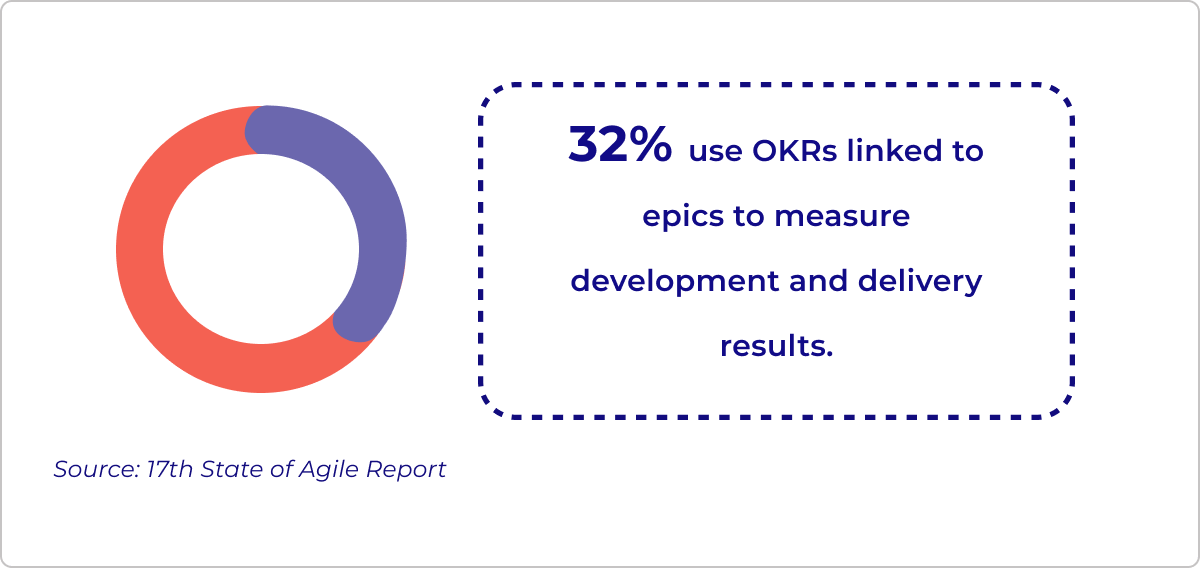
What Are the Benefits of Agile?
5. 39% of respondents employing an Agile project management approach report the highest average project performance rate, resulting in an overall project success rate of 75.4%.
The data reveals that 39% of respondents employing Agile in their project management ways have the highest average project performance rate, slightly surpassing those using predictive (74.4%) or hybrid (74.6%) methods. This suggests that while there is a minimal difference in project success rates between the approaches, organizations recognize the value of a combined strategy emphasizing predictability, adaptability, and innovation. This underscores the importance of embracing a flexible project management approach that can navigate the complexities of digital transformation effectively.
6. Almost three in five Agile practitioners are satisfied because of a better alignment with business needs.
Professionals across various roles, including Agile coaches, Scrum masters, project managers, consultants, and trainers, echo similar benefits from Agile adoption. Specifically, 59% report enhanced collaboration, while 57% note better alignment with organizational objectives.
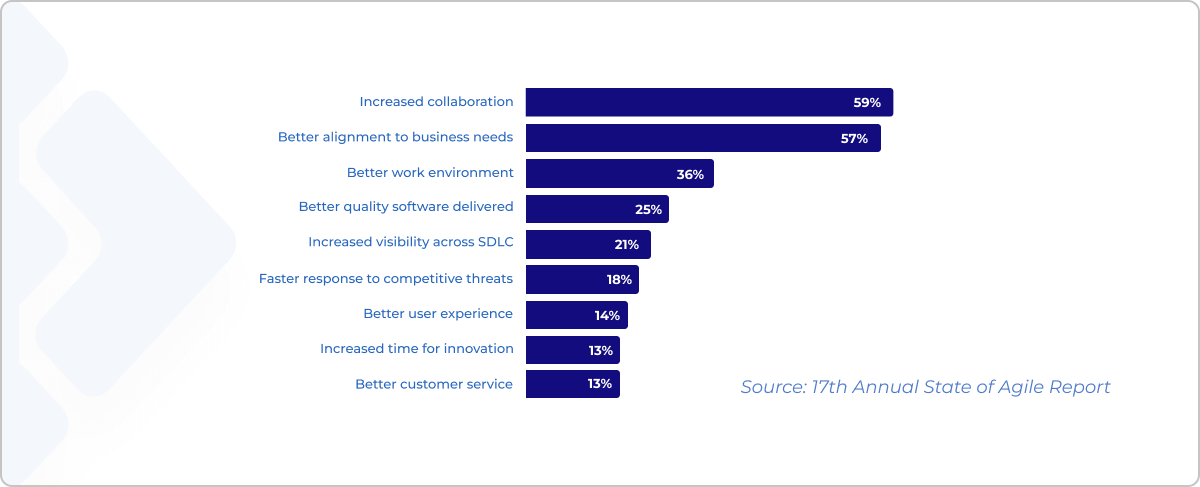
7. 87 companies under co-CEO leadership reveal superior returns compared to firms led by a sole CEO.
The success of this model hinges on several factors, including mutual commitment, complementary skills, defined responsibilities, conflict resolution mechanisms, and shared accountability. While not universally suitable, this approach is particularly effective for Agile companies and organizations undergoing technology transformations.
- Harvard Business Review: Is It Time to Consider Co-CEOs?
8. Business units that have fully embraced an agile model demonstrated greater resilience in facing the challenges presented by COVID-19.
A joint investigation conducted by McKinsey and Harvard Business School analyzed 25 organizations across seven industries that have or are transitioning to an Agile methodology. The study uncovered that these companies exhibited enhanced readiness to confront the repercussions of the pandemic, as evidenced by metrics such as customer satisfaction, employee engagement, and operational efficiency.
- McKinsey & Company: An operating model for the next normal: Lessons from agile organizations in the crisis
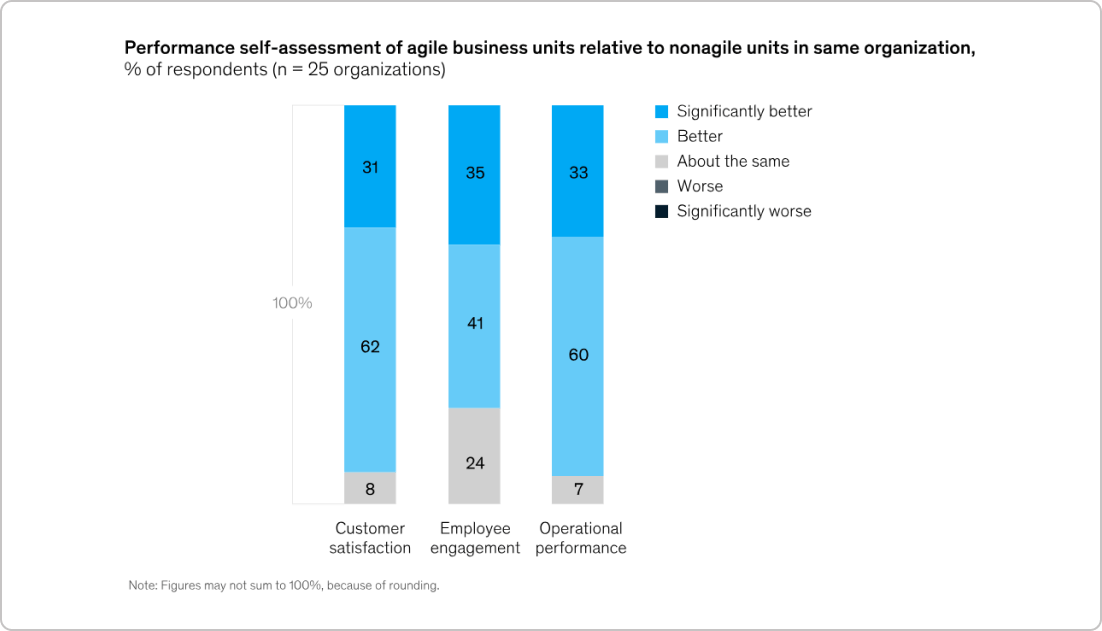
What Are the Agile Challenges?
The adoption of Agile can be a challenging endeavor, often involving numerous unknowns and obstacles. Questions may arise regarding how individuals will embrace new values throughout the organization and the duration of this transition.
9. Nearly half of Agile practitioners (47%) believe that "generalized" resistance to organizational change or a "culture clash" are the greatest obstacles to Agile adoption.
Agile adoption presents notable challenges, with widespread resistance to organizational change and cultural clashes emerging as significant obstacles, marking a 7-point increase from 2022. Additionally, the persistent lack of sufficient leadership participation, cited by 41% of respondents, remains a consistent challenge for the second consecutive year.
10. Only 32% of business leaders are actively involved in spearheading company-wide Agile transformations.
While executives typically lead Agile transformation initiatives, the level of active engagement could be much higher. This suggests that Agile adoption is often confined to individual technical teams, indicating a gap between leadership vision and organizational implementation. To achieve comprehensive Agile incorporation, it's necessary to see greater executive involvement and commitment throughout the transformation process.
11. Close to 75% of respondents indicate that their organization lacks support for an Agile culture, regardless of the maturity of their current Agile practices.
The data underscores a widespread challenge across organizations, with culture and performance management consistently identified as the most significant obstacle. Despite efforts to adopt Agile methodologies, the absence of an enabling culture poses a grand barrier to effective implementation and realization of Agile principles. Addressing cultural barriers and enhancing performance management practices are crucial steps for organizations seeking to fully embrace Agile ways of working.
- KPMG: Survey on Agility 2019
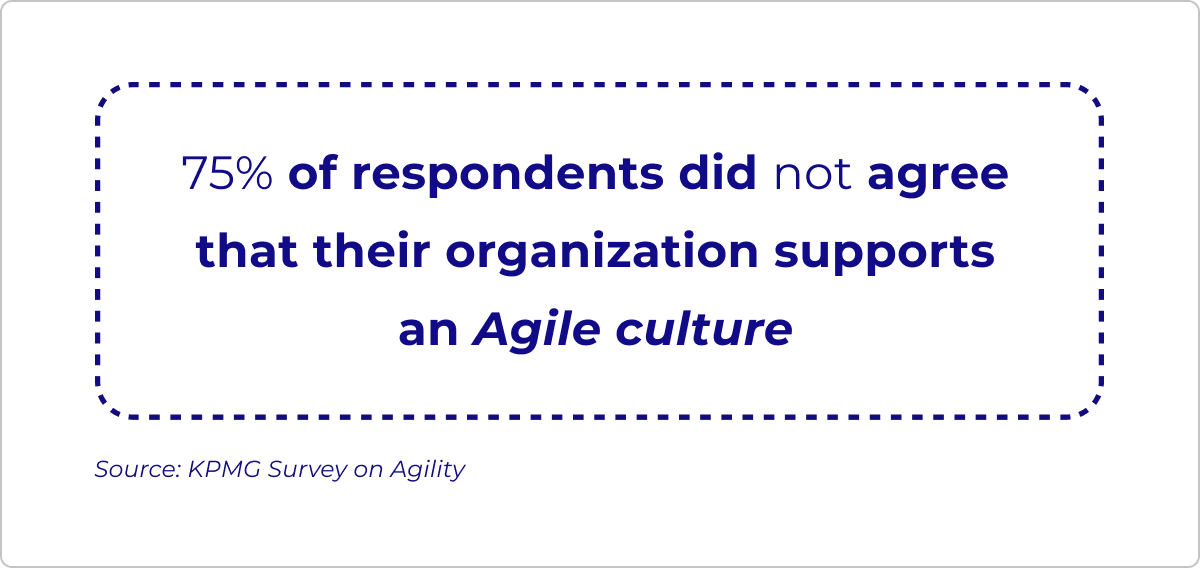
The Rise of Hybrid Approaches
Hybrid project management methodologies combine the strengths of different approaches to effectively manage projects and adapt to varying project requirements and environments.
12. Annual global financial losses due to project failures amount to a staggering $3 trillion.
The alarming financial implications of project failures have spurred the development of new project management methodologies. Hybrid management approaches, such as combining elements of Waterfall and Agile methodologies, have gained traction in response to the challenges posed by complex projects and evolving requirements. This emerging hybrid approach empowers project leaders to tailor their project management strategies to suit their unique organizational needs, enhancing adaptability and improving project outcomes.
- Harvard Business Review: It's Time to End the Battle between Waterfall and Agile
13. The adoption of hybrid project management approaches has steadily risen over the past three years, increasing by 57% from 20% in 2020 to 31.5% in 2023.
The growth trend toward using hybrid project management approaches is expected to continue, with 76% and 73% of practitioners expecting an increase in their organization's usage of Agile and hybrid approaches.
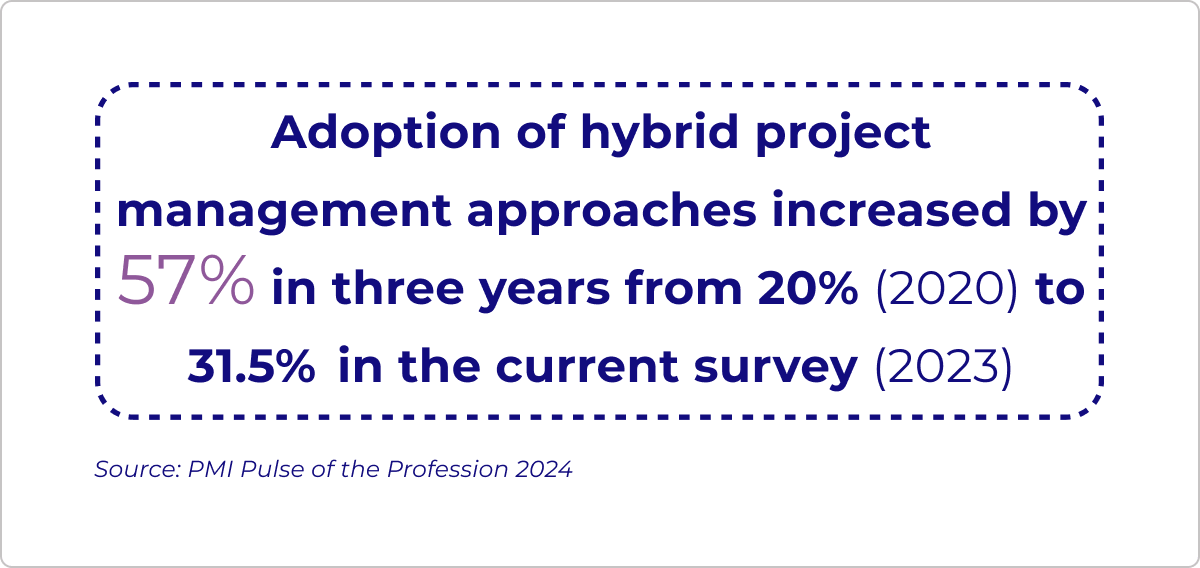
14. The use of the Scaled Agile Framework (SAFe) has decreased significantly. Only 26% of respondents indicated its use, marking a more than 50% decrease from the previous year.
This notable shift can be attributed to introducing new options for describing Agile methodologies within organizations. With choices such as "We created our own enterprise Agile framework" or "We don't follow a mandated Agile framework at the enterprise level" (34%), organizations are increasingly opting for tailored approaches rather than standardized frameworks like SAFe. Additionally, other established methodologies like Scrum @ Scale or Scrum of Scrums have also experienced a decline in usage, indicating a broader trend toward hybrid Agile practices tailored to specific organizational needs.
15. The adoption of hybrid approaches is most prevalent in information technology (55%), healthcare (53%), and financial services (53%) industries.
16. Among project managers, 37% adopt a hybrid approach, integrating agile and predictive methodologies across the project life cycle.
17. Nearly half of large companies (49%) and medium-sized companies (45%) have embraced a hybrid approach.
Large and medium-sized companies have incorporated Agile, DevOps, iterative, Waterfall, Lean, and Spiral methodologies into their software development life cycle (SDLC). This trend suggests that larger organizations are more inclined to adopt a hybrid model, which combines various methodologies to suit their unique needs and project requirements.
Agile Statistics: Food for Thought
The decision to pivot towards a hybrid model, embrace a particular framework, or gauge whether your organization is ready for transformation rests in your hands. What we aim for with the Agile statistics presented above is to spark your curiosity and encourage a spirit of exploration and experimentation.
Businessmap is the most flexible software, helping your company gain visibility across all projects/portfolios, align on goals, and deliver quality work faster.

Iva Krasteva
Content Strategist | Agile Practitioner | Kanban Certified
Iva is a Kanban-certified Agile expert with hands-on experience in SEO, content creation, and Lean practices. She has published dozens of articles on Lean, Agile, and Kanban practical applications. Iva actively promotes collaborative, flexible work environments and regularly shares process optimization insights through writing.



